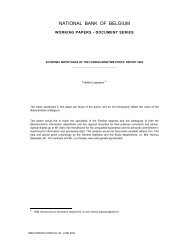A multi-factor model for the valuation and risk management of ...
A multi-factor model for the valuation and risk management of ...
A multi-factor model for the valuation and risk management of ...
You also want an ePaper? Increase the reach of your titles
YUMPU automatically turns print PDFs into web optimized ePapers that Google loves.
Table 2: Deposit premium <strong>and</strong> duration estimates in <strong>the</strong> literature<br />
Literature Hutchison <strong>and</strong> Pennacchi (1996) O’Brien (2000)<br />
200 banks, 1986-1990 > 75 banks, 1983-1994<br />
NOW median premium 6.6% 21.1%<br />
[10%; 90%] quantile [-5%; 25%] [8.0%; 36.6%]<br />
MMDA median premium 7.9% 12.2%<br />
[10%; 90%] quantile [-2.5%; 18%] [-0.1%; 21.8%]<br />
NOW median duration 6.7 years 1.09 & 0.70 years a<br />
[10%; 90%] quantile [2 year; 9 year]<br />
MMDA median duration 0.4 years 0.5 & 0.25 years a<br />
[10%; 90%] quantile [-2 year; 2 year]<br />
a Duration estimates <strong>for</strong> a 100bp upward <strong>and</strong> 100bp downward shock, respectively, <strong>for</strong> <strong>the</strong> median bank, <strong>and</strong> where<br />
deposit rates react asymmetrically to market rate changes. See O’Brien (2000) <strong>for</strong> duration estimates where <strong>the</strong> shocks<br />
di¤er in size <strong>and</strong>/or where deposit rate dynamics are assumed to adjust symmetrically.<br />
3 Empirical implementation <strong>and</strong> estimation results<br />
3.1 Data<br />
The <strong>valuation</strong> <strong>and</strong> <strong>risk</strong> <strong>management</strong> <strong>of</strong> deposits is <strong>of</strong> particular relevance <strong>for</strong> continental European<br />
countries with <strong>the</strong>ir relatively large <strong>and</strong> stable deposit volumes, <strong>and</strong> even more <strong>for</strong> Belgium, given<br />
that <strong>the</strong>re is speci…c price regulation in place that aims to stabilize <strong>the</strong> volume <strong>of</strong> deposits. Total<br />
savings deposits balances in Belgium have grown in absolute numbers from 60 billion euro in<br />
December 1994 to 158 billion in June 2005, roughly 50% <strong>of</strong> Belgian 2005 GDP. 10 The share <strong>of</strong><br />
savings deposits in total bank liabilities also increased from 10.3% to 15.5% in <strong>the</strong> last decade, <strong>and</strong><br />
households allocated as much as 20% <strong>of</strong> <strong>the</strong>ir wealth in this type <strong>of</strong> account. Substantial variation<br />
exists across banks in <strong>the</strong> importance <strong>of</strong> this balance sheet post, according to bank specialization<br />
<strong>and</strong> size. For example, whereas savings deposits account <strong>for</strong> 11% <strong>of</strong> liabilities on average <strong>for</strong> <strong>the</strong><br />
4 largest Belgian banks in 2004, this average proportion reaches 43% <strong>for</strong> <strong>the</strong> medium-size banks<br />
specialized in <strong>the</strong> distribution <strong>of</strong> this product.<br />
The Belgian …nancial system is characterized by a highly concentrated banking sector. Basically<br />
four conglomerates dominate <strong>the</strong> banking <strong>and</strong> insurance sector. We present estimation results <strong>for</strong> a<br />
sample <strong>of</strong> eight Belgian banks, <strong>the</strong> four conglomerates (Dexia, Fortis, ING, KBC) <strong>and</strong> four mediumsized<br />
banks that rank as most important issuers <strong>of</strong> savings deposits after <strong>the</strong> four conglomerates,<br />
<strong>and</strong> based on <strong>the</strong> period 1994:Q4-2005:Q2 (43 quarterly observations). Taken toge<strong>the</strong>r, <strong>the</strong> selected<br />
banks have a 86% market share in June 2005 (135 billion euro <strong>of</strong> savings deposits). A number<br />
<strong>of</strong> speci…c issues arise in <strong>the</strong> Belgian context, as Belgian law introduces regulation a¤ecting <strong>the</strong><br />
pricing, remuneration structure, <strong>and</strong> …scal treatment <strong>of</strong> savings deposits (Royal Decree <strong>of</strong> August<br />
27 1993 (KB/WIB 1992)). 11<br />
10 Sight deposit accounts, being <strong>the</strong> actual transaction or checking account, are characterized by a low quasiconstant<br />
remuneration <strong>and</strong> amount to ano<strong>the</strong>r 117 billion euro in June 2005. Although <strong>the</strong>se accounts can also be<br />
regarded as DDAs <strong>and</strong> although banks attach relatively long durations to <strong>the</strong>se deposits, at least <strong>for</strong> <strong>the</strong> core part<br />
<strong>of</strong> <strong>the</strong> balances, we leave <strong>the</strong>ir treatment <strong>for</strong> future research.<br />
11 First, savings deposits in Belgium enjoy a favorable …scal treatment, as interest earned on savings deposits<br />
is exempt from <strong>the</strong> withholding tax (currently 15 p.c.) up to an amount <strong>of</strong> EUR 1520 <strong>of</strong> annual interest income<br />
per taxpayer. Second, strictu sensu, savings deposits are not true dem<strong>and</strong> deposits as Belgian law allows depositissuing<br />
banks to legally restrict withdrawals to EUR 2500 in any two-week period <strong>and</strong> to require a 5-day notice <strong>for</strong><br />
withdrawals exceeding EUR 1250. Third, <strong>the</strong> remuneration <strong>of</strong> savings deposits is at <strong>the</strong> discretion <strong>of</strong> <strong>the</strong> banks, but<br />
must always consist <strong>of</strong> a base rate <strong>and</strong> a growth or loyalty premium. While <strong>the</strong> base rate is paid out proportionally<br />
with time (pro rata), <strong>the</strong> payout <strong>of</strong> <strong>the</strong> premium component is relatively complex <strong>and</strong> not fully transparant <strong>and</strong><br />
hinges upon <strong>the</strong> time <strong>the</strong> (new) deposits remain on <strong>the</strong> account (typically 6 or 12 months is required) <strong>and</strong> on<br />
intricate daycount conventions. Both <strong>the</strong> base rate <strong>and</strong> <strong>the</strong> premiums are legally capped. Since April 1990, <strong>the</strong> legal<br />
ceiling has remained unchanged at 6 p.c., i.e. a base rate ceiling <strong>of</strong> 4 p.c. <strong>and</strong> a premium ceiling <strong>of</strong> 2 p.c.. Between<br />
December 1983 <strong>and</strong> April 1990, <strong>the</strong> ceiling has been changed on various occasions by <strong>the</strong> Minister <strong>of</strong> Finance,<br />
typically in line with <strong>the</strong> general interest rate market environment. Fourth, savings deposits can be thought to be<br />
<strong>risk</strong> free, as balances are guaranteed, up to a certain amount, by <strong>the</strong> Belgian Protection Fund <strong>for</strong> Deposits <strong>and</strong><br />
10
















